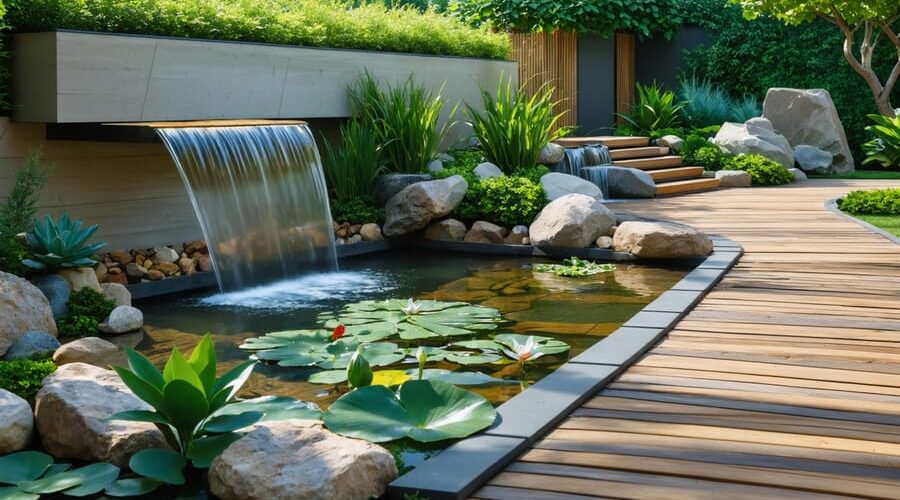
Transform Your Backyard: How to Design a Stunning DIY Water Feature
Transform your outdoor space into a tranquil oasis with a custom water feature that captures the soothing essence of nature. Whether you envision a cascading waterfall, a serene pond, or a modern fountain, water feature design combines artistic vision with practical engineering to create lasting beauty. Understanding the fundamentals of water movement, material selection, and spatial planning empowers DIY enthusiasts to craft stunning installations that enhance any landscape.
The magic of a well-designed water feature lies in its ability to engage multiple senses – the gentle splash of falling water, the shimmer of sunlight on rippling surfaces, and the cooling effect on hot summer days. From small courtyard fountains to grand backyard waterfalls, successful designs balance aesthetic appeal with sustainable functionality. With proper planning, even beginners can create professional-looking features that provide years of enjoyment while minimizing maintenance requirements.
Before diving into your project, consider how your water feature will interact with existing landscape elements, local climate conditions, and your property’s natural topography. This thoughtful approach ensures your creation becomes an integral part of your outdoor living space rather than an afterthought.
Planning Your Perfect Water Feature
Assessing Your Space and Budget
Before diving into your water feature project, it’s essential to carefully evaluate your available space and resources. Start by measuring your intended installation area, considering not just the feature’s footprint but also maintenance access and viewing angles. Remember that water features can attract local wildlife, so you’ll want to ensure adequate surrounding space.
Assess your site’s natural sunlight patterns throughout the day. Too much direct sunlight can promote algae growth and increase water evaporation, while too little might limit your plant options. For powered features, locate your nearest electrical outlet and factor in the cost of professional installation if needed.
Your budget will influence the scale and complexity of your water feature. Beyond initial construction costs, account for:
– Pump and filtration equipment
– Construction materials
– Plants and decorative elements
– Monthly utility costs
– Seasonal maintenance supplies
– Professional services if required
A good rule of thumb is to set aside 15-20% of your total budget for unexpected expenses. For smaller spaces or modest budgets, consider self-contained features like wall fountains or tabletop designs. Larger yards with generous budgets might accommodate elaborate pond systems or cascading waterfalls. Whatever your constraints, there’s always a water feature solution that can work within your parameters.
Choosing Your Water Feature Style
When designing your water feature, you’ll want to consider which style best matches your garden’s personality and your maintenance preferences. Formal features, like geometric fountains and structured pools, create an elegant, sophisticated atmosphere perfect for modern landscapes. These typically require less maintenance and work well in smaller spaces.
For a more natural look, consider creating garden waterfalls or meandering streams. These features mimic nature’s own designs and create a peaceful, woodland-like atmosphere. While they may need more maintenance, the soothing sounds and organic appearance make them worth the extra effort.
Wall fountains are excellent space-savers that add vertical interest and gentle water music to patios or small gardens. For those seeking simplicity, self-contained water features like tabletop fountains or ceramic vessels provide easy-to-manage options that can be moved around as needed.
Pond-based features offer the most diverse possibilities, combining water movement with opportunities for aquatic plants and fish. These living ecosystems create dynamic focal points but require careful planning and regular maintenance.
Remember, your chosen style should reflect both your aesthetic preferences and practical considerations like available space, budget, and the time you can dedicate to maintenance. Start small if you’re new to water gardening – you can always expand or add complexity as your experience grows.
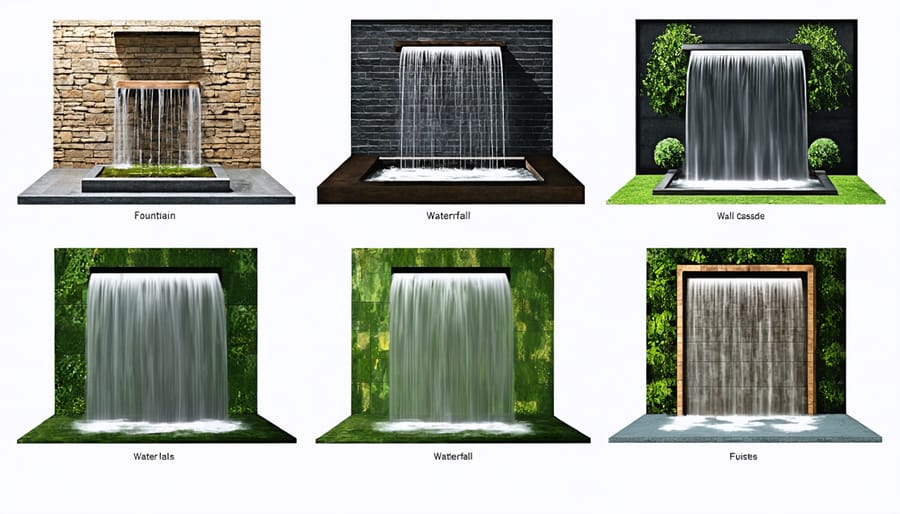
Essential Design Elements
Water Flow and Movement
Water movement is the heart and soul of any water feature, creating that captivating ambiance that draws people in. Whether you’re aiming for a gentle trickle or a dramatic cascade, understanding how water flows will help you achieve the perfect effect.
The key to successful water movement lies in pump selection and placement. For a peaceful, zen-like atmosphere, consider a gentle flow rate of 100-200 gallons per hour. This creates subtle ripples and soft sounds perfect for meditation gardens. For more dramatic effects, like waterfalls, you’ll want higher flow rates of 500-1000 gallons per hour to achieve that satisfying splash and white-water effect.
Height differences significantly impact water movement. A drop of just 6 inches creates a gentle pour, while drops of 2 feet or more produce more dramatic cascades. Remember that multiple small drops often create better sound effects than one large fall, as they allow water to interact with more surfaces.
Different materials and textures also influence how water moves. Smooth surfaces create sheet-like flows, while rough or irregular surfaces break up the water into more intricate patterns. Try incorporating various materials like slate, river rock, or copper sheets to achieve different effects.
Consider incorporating multiple flow patterns in your design. Combining a main waterfall with smaller tributary streams or a series of stepped falls adds visual interest and creates layered sound effects. Just ensure your pump can handle the total water volume needed for all features.
Don’t forget about wind effects – position your water feature so prevailing winds won’t cause excessive spray or water loss. This thoughtful planning ensures your water feature performs beautifully in all conditions.
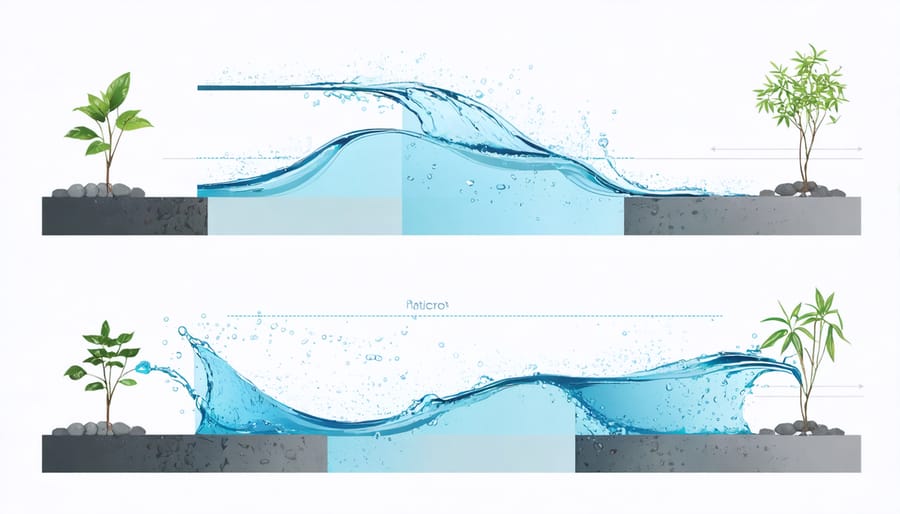
Material Selection
When creating a water feature, selecting the right materials is crucial for both longevity and visual appeal. Start with DIY-friendly materials that match your design vision while ensuring durability against water exposure and weather conditions.
For the main structure, natural stone like slate, granite, or limestone offers timeless beauty and excellent durability. These materials age gracefully and blend seamlessly with garden landscapes. Alternatively, concrete provides versatility and cost-effectiveness, allowing you to create custom shapes and finishes while maintaining structural integrity.
When selecting containers and basins, opt for materials specifically designed for water features. High-quality plastic or fiberglass reservoirs are lightweight and resistant to cracking, while preformed pond liners offer reliable waterproofing. For a more upscale look, copper or stainless steel elements add sophistication and naturally develop an attractive patina over time.
Don’t forget about the importance of proper plumbing materials. Use UV-resistant PVC pipes and fittings for hidden components, and choose pumps with corrosion-resistant housings. For visible elements like spouts or fountainheads, consider brass or stainless steel fixtures that combine functionality with aesthetic appeal.
Remember to factor in your local climate when selecting materials. In regions with freezing winters, choose frost-resistant materials and avoid porous stones that might crack. For sunny areas, pick materials that won’t fade or deteriorate under UV exposure. This thoughtful selection of materials will ensure your water feature remains beautiful and functional for years to come.
Lighting and Sound Design
The right lighting and sound design can transform your water feature from a daytime attraction into a mesmerizing nighttime display. When planning your lighting effects for water features, consider using LED underwater lights, which are energy-efficient and long-lasting. Position lights at different depths and angles to create dramatic shadows and highlights that dance with the moving water.
For smaller features, one or two strategically placed lights can create stunning effects, while larger installations might benefit from multiple lighting zones. Color-changing LEDs can add an extra dimension of excitement, though classic white lighting often provides the most natural and elegant look.
Sound management is equally important in water feature design. The sound of falling water can range from a gentle trickle to a dramatic splash, depending on how you direct the flow. For a peaceful atmosphere, create multiple small drops rather than one large fall – this produces a softer, more musical sound. If you’re looking for a more dramatic effect, consider incorporating wider falls or cascade designs that create white noise.
Remember that water sounds can vary throughout the day as wind conditions change. Test your feature at different times and adjust the flow rate using a variable-speed pump to find the perfect balance. In urban settings, you might want a slightly louder flow to mask traffic noise, while in quiet gardens, a subtle sound might be more appropriate.
For nighttime ambiance, consider motion-activated lighting that creates a subtle glow when someone approaches. Solar-powered lights are an eco-friendly option, though they may not provide the same intensity as hardwired fixtures. Whatever lighting you choose, ensure all electrical components are properly rated for outdoor use and installed according to local safety codes.
Finally, remember that both lighting and sound elements should complement rather than overwhelm your overall garden design. The goal is to enhance the natural beauty of your water feature while creating an inviting atmosphere for both day and night enjoyment.
Creating Your Blueprint
Sketching Your Design
Sketching your water feature design is an essential first step that helps bring your vision to life while identifying potential challenges early on. Start with a simple bird’s-eye view drawing of your yard, using graph paper for better scale accuracy. Mark one square as equal to one foot to maintain proper proportions.
Begin by drawing the outline of your property, including existing elements like your house, trees, and pathways. Next, sketch the proposed location of your water feature, considering natural viewing points from windows and seating areas. Use basic shapes initially – circles for ponds, straight or curved lines for streams, and squares or rectangles for formal fountains.
Include these key elements in your sketch:
– Water depth variations (shown through different shading)
– Edge details and transitions
– Planting zones around the feature
– Seating areas or viewing points
– Equipment locations (pump, filter, electrical connections)
– Lighting positions
– Rock placement and waterfall details
Don’t worry about artistic perfection – focus on clarity and functionality. Use different colors to distinguish between various elements: blue for water, green for plants, and brown for rocks. Add arrows to indicate water flow direction and mark the slope of the land with simple contour lines.
Create multiple versions of your sketch to explore different design possibilities. Consider drawing both overhead and side-view perspectives to better understand how your water feature will look from different angles. Keep these sketches handy as you move forward with your project – they’ll serve as valuable reference points during construction.
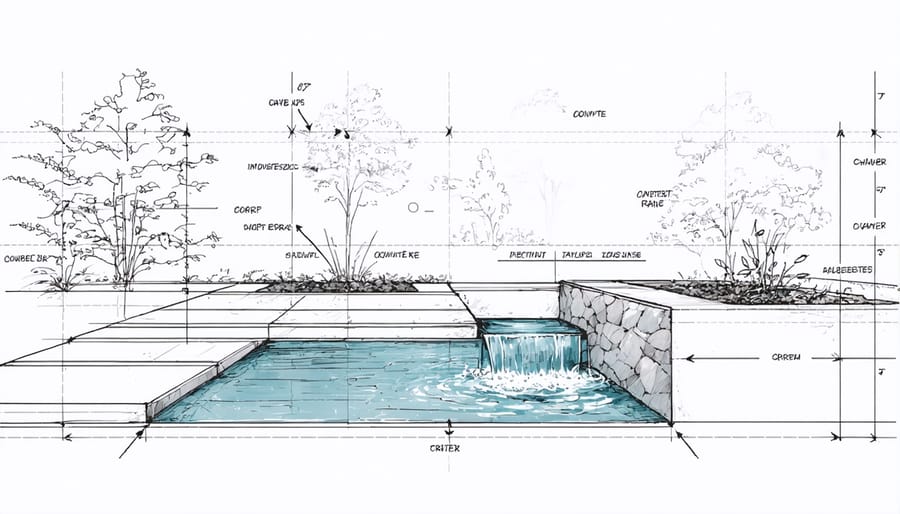
Technical Specifications
Getting your water feature’s measurements right is crucial for success. Start by calculating the total water volume you’ll need. For a pond, multiply the length by width by average depth (in feet) and then multiply by 7.48 to convert to gallons. For streams or waterfalls, estimate about 1 gallon per inch of width per foot of stream length.
Your pump size depends on this volume – a good rule of thumb is circulating the entire water volume once every hour. For waterfalls, you’ll need about 1 gallon per minute per inch of waterfall width for a natural look. Choose a pump that’s slightly oversized to account for head height (vertical distance water needs to travel) and friction loss in pipes.
For filtration, plan on mechanical filters handling about 50% of your total water volume per hour. Biological filtration needs vary, but allow roughly 1 cubic foot of filter media per 1,000 gallons of water. UV clarifiers, if desired, should be sized at 8-10 watts per 1,000 gallons.
Plumbing requirements depend on flow rate. For most home water features, 1½-inch diameter pipes work well for flows up to 4,000 gallons per hour. Use larger 2-inch pipes for higher flow rates. Remember to include enough pipe length for maintenance access and to hide pipes from view.
When planning electricity, ensure all outlets are GFCI-protected and allow for about 2-3 watts per gallon of water for basic pump operation. Add extra capacity if you’re planning additional features like lights or fountains. Always leave a 15% margin in your calculations to ensure smooth operation.
Safety and Maintenance Planning
Safety should always be a top priority when designing your water feature. Start by incorporating non-slip surfaces around the perimeter using textured stone or rubber matting. If your feature includes deep sections, consider installing safety ledges or shallow shelves that provide a step-up zone in case someone falls in.
For features with electrical components, ensure all wiring meets local safety codes and install GFCI (Ground Fault Circuit Interrupter) outlets to prevent electrical accidents. Place pumps and filters in easily accessible locations, protected from the elements but reachable for routine maintenance requirements.
When designing access points, include stepping stones or maintenance platforms that allow you to reach all areas of your water feature safely. If you’re installing a pond, create a gradual slope around the edges to prevent accidental slipping. For families with small children, consider installing protective barriers or grates just below the water surface.
Remember to plan for winter safety too. Include drainage points to prevent ice damage, and mark underwater features that might become hidden when covered in snow. Installing adequate lighting not only enhances the feature’s nighttime appeal but also improves safety during evening maintenance tasks.
Keep all maintenance tools and cleaning supplies in a nearby, weatherproof storage area, making routine upkeep more convenient and encouraging regular maintenance habits.
Common Design Mistakes to Avoid
When creating a water feature, avoiding common design mistakes can save you time, money, and frustration. One of the biggest errors is underestimating the importance of proper sizing. A feature that’s too small can look insignificant in your landscape, while one that’s too large can overwhelm the space and strain your budget.
Poor placement is another frequent pitfall. Installing a water feature in a low spot where runoff collects can lead to flooding and contamination. Similarly, placing it too close to trees means dealing with constant leaf debris and potential root damage. Consider sun exposure too – too much direct sunlight can cause excessive algae growth and water evaporation.
Many DIY enthusiasts make the mistake of skimping on filtration systems. An inadequate filter leads to murky water and increased maintenance. Along the same lines, installing insufficient lighting can limit your enjoyment of the feature after dark and create safety hazards.
Another common error is failing to plan for winter. In colder climates, not incorporating proper depth or freeze protection can result in damaged pumps and cracked containers. Speaking of pumps, choosing the wrong size pump is a frequent mistake – too powerful, and you’ll create a noisy waterfall; too weak, and your feature will look lifeless.
Don’t forget about maintenance access. Many people design beautiful features but make them difficult to clean or repair. Ensure you can easily reach all components for regular maintenance. Lastly, avoid the temptation to overcrowd your water feature with too many elements. A cluttered design with too many plants, rocks, or decorative items can look chaotic rather than peaceful.
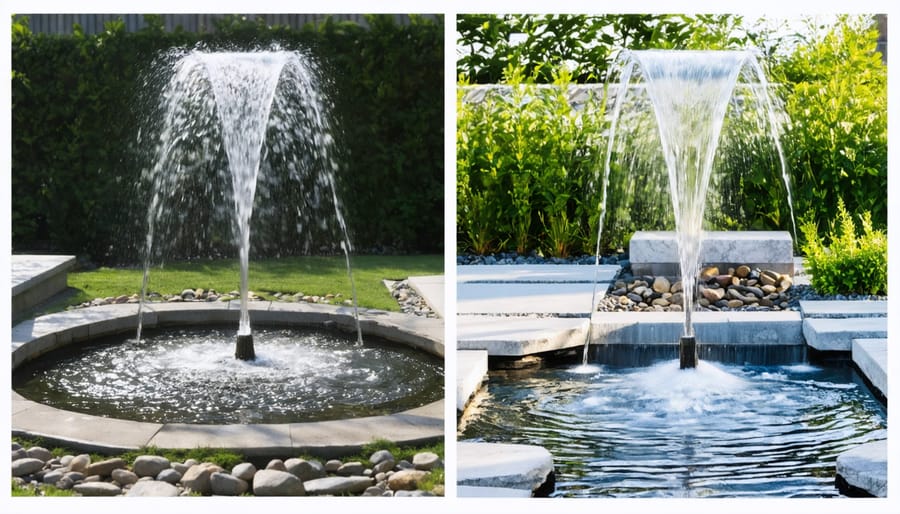
Creating your own water feature is an exciting journey that can transform your outdoor space into a peaceful sanctuary. Throughout this guide, we’ve explored the essential elements of water feature design, from choosing the perfect location to selecting materials and understanding water circulation systems. Remember that successful water features blend aesthetics with practicality, creating a balance between visual appeal and functionality.
Whether you’re dreaming of a serene pond, a dramatic waterfall, or a simple fountain, the key is to start with a solid plan and take your time with each step. Don’t be afraid to get creative while keeping maintenance requirements in mind. Your water feature should reflect your personal style while complementing your existing landscape.
Now that you have the knowledge and tools to begin, take that first step toward creating your own backyard oasis. Start sketching your ideas, gathering materials, and planning your installation. With patience and attention to detail, you’ll soon be enjoying the soothing sounds of flowing water in your own custom-designed water feature. The satisfaction of building it yourself will make the experience even more rewarding.
